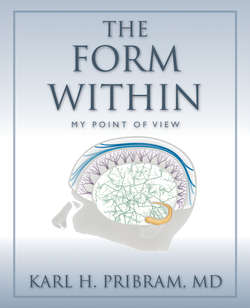Читать книгу The Form Within - Karl H Pribram - Страница 48
На сайте Литреса книга снята с продажи.
Form as Pattern
ОглавлениеA different path of experimentation led me to explore the view of form as pattern. In my earlier research, while examining the effects of cortical removals on the behavior of monkeys, I had to extensively examine the range of responses to stimuli that were affected by removing a particular area of the brain cortex. Thus, during the 1960s, when I began to use micro-electrodes, I used not only a single line but two lines in my receptive field experiments. The relationship of the lines to one another could thus be explored. Meanwhile, other laboratories began to use multiple lines and I soon followed suit.
Multiple lines of different width and spacing (that is, stripes) produce a “flicker” when moving across the visual field. We experience such a flicker when driving along a tree-lined road: the rapid alternation of such light and shadow stripes can actually incite a seizure in seizure-prone people. The rapidity of the flicker, the speed of the alternation between light and dark can be described mathematically in terms of its frequency.
When we moved such stripes before the eye of a subject in our experiments, we could change the response of the subject’s cortical receptive field by changing the frequency of the stimulation in two ways: by altering the speed at which we moved the stimulus, or by changing the width of the stripes and the spaces between them.
Mathematically, this relationship among the angles on the retina that result from stimulation by stripes is expressed as degrees of arc of the portion of a circle. A circle, as noted earlier, represents a cycle. Degrees of arc are measures of the density, the rapidity of oscillations between light and dark in the cycle. Thus, the oscillations are the spectral transform of the spatial widths of the alternating light and dark stripes. It follows that changes in the width of the light and dark stripes will change the frequency spectrum of the brain response.
Those of us who used multiple lines in our experiments have described our results in terms of “spatial frequency.”Frequency over space as distinct from frequency over time can be demonstrated, for example, if we visually scan the multiple panels that form a picket fence or similar grating. When we visually scan the fence from left to right, each panel and each gap in the fence projects a pattern of alternating a bright region and a shadow region onto the curve of our retina. Therefore, each bright region and each shadow covers an angle of the curve of our retina. The “density” of angles is defined by how close the stimulating bright and dark regions (the width of the fence panels and their spacing) are to each other.
17. Low- and High-Frequency Gratings
18. Receptive Field and Contours
In our hearing, within the acoustical domain, we have long been accustomed to thinking in terms of the temporal frequency of a sound determining its pitch. In seeing, we now had demonstrated that a visual pattern, an image, is determined in the same fashion by its spatial frequency. “Wow! The eye works just like the ear.” This insight— that all senses might function in a similar mode—was a most dramatic revelation. My long-sought quest for a way to understand the processing of the visual as radiation, similar to the processing of color, was at last realized.
